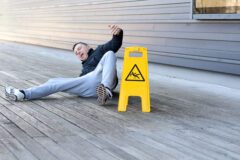6 First Aid Tips You Should Know for the Most Common Types of Injuries

Accidental injuries occur when you least expect them, so it’s crucial to be prepared for danger. Knowing how to provide first aid can save lives or, at the very least, provide your loved one with the care necessary before a professional can evaluate the wound.
Most Common Kinds of Injuries
Injuries impact millions of people across the world and are one of the leading causes of death, according to the CDC. The most common types of injuries include the following:
Slip and Fall Accidents
Slip and falls occur due to a loss of traction between your foot and the ground. These injuries result in falls and may or may not lead to further damage.
Object Injuries
Object injuries typically occur due to a foreign object falling, rolling, or striking a person. This type of injury is most common in the workplace, although it can happen anywhere. These wounds range from minor to extremely serious, life-altering injuries.
Automobile Accident Injuries
Along with car wrecks, motorcycle collisions, and trucking accidents, pedestrians and bike riders are also involved in deadly accidents with automobiles. These accidents range from minor fender benders to fatal accidents, so injuries vary widely.
Chemical or Thermal Burns
Chemical burns occur when the skin comes into contact with a highly caustic solution which can cause damage to the skin tissue. On the other hand, thermal burns involve burns sustained through a hot surface, liquid, or flame. They cause similar injuries to chemical burn victims.
Poisoning
Poisoning is one of the most common causes of accidental deaths, most of which occur inside the home. Poisoning is typically a result of the presence of everyday household items such as household cleaners, automobile or maintenance products, and poisonous food items.
6 Types of Lifesaving First Aid Tips
Calling 911 immediately is, bar none, the most important thing you can do after an accident. Additionally, the type of first aid you will need to administer to a victim depends entirely on their injury. Here are several tips according to the most common types of injuries:
Bleeding
A victim who is bleeding requires steps to prevent further loss of blood. This includes leaving any shards of glass or pieces of metal lodged inside of their skin alone. Removing it can cause excessive blood loss and must only be done by a doctor. You should apply direct pressure to any open wounds until the bleeding stops. You may cover the bleeding with a clean compress and bandage if the bleeding stops.
Burns
As there are several different types of burns, knowing how to treat them can be difficult. Thermal, electrical, and chemical burns require slightly different treatments; however, some basic rules apply to each. First, ensure the victim is breathing. If not, administer CPR. Next, evaluate the burn’s severity and eliminate the source of the burn as quickly as possible (if it’s an electrical burn, turn off the electricity; if it’s a thermal burn, move safely away from the fire). For chemical burns, it’s important to flush the wound with water to remove any chemicals still in contact with the skin. If possible, cover the burns loosely with a sterile bandage wrap and wait for help to arrive.
Spinal Cord, Brain, and Neck Injuries
Head, neck, and spinal cord injuries could be exceptionally severe, and moving the victim could result in further injury or paralysis. It’s vital to leave the victim as still as possible and not to move any part of their body, regardless of what position their body may be in. However, you may provide support to their hands and feet by using rolled towels to place underneath. If the victim isn’t breathing, apply CPR, but avoid moving or tilting their head back. Keep the victim in the same position until the ambulance arrives.
Poisoning
Applying first aid to the victim will depend on understanding the type of poison that was ingested. Try to determine what item is causing the poisoning. If you can identify the source, read the label for instructions on what to do to counteract the poisoning. Wash or remove any poison from exterior parts of their body (such as eyes or mouth) and begin CPR if the victim is unconscious. If the victim starts vomiting, turn them on to their side to prevent them from choking. Call 911, go to the emergency room, and call the National Poison Control Center hotline at 1-800-222-1222.
Choking
If someone is choking, immediately place the victim in a standing position. While they remain standing, lean them slightly forward and use your palm to hit them five times on the back between their shoulder blades. Then, perform the Heimlich maneuver by placing your arms around their waist and, with your fists placed just above their navel, give five quick thrusts upward and in. Continue these two moves until the object is removed or until help arrives.
Loss of Consciousness
When someone has lost consciousness, it’s essential to keep them positioned where they lay in case there is any possibility they might have sustained a brain or spinal cord injury. Try checking for consciousness by tapping rather than shaking the victim. If there is no response, check for a pulse. Check their airway for any potential objects blocking their breathing. Perform the Heimlich maneuver if necessary, or remove the blockage with your hands. If the victim is not breathing or has no pulse and nothing is blocking their airway, begin CPR. If they have a pulse, keep them warm until help arrives and check on their vital signs frequently.
Conclusion
Knowing the basics of applying first aid is an invaluable and lifesaving tool, especially during an accidental injury. With some common sense and little knowledge, your ability to think fast and react to a dire situation such as an accident can be the deciding factor between life or death.






